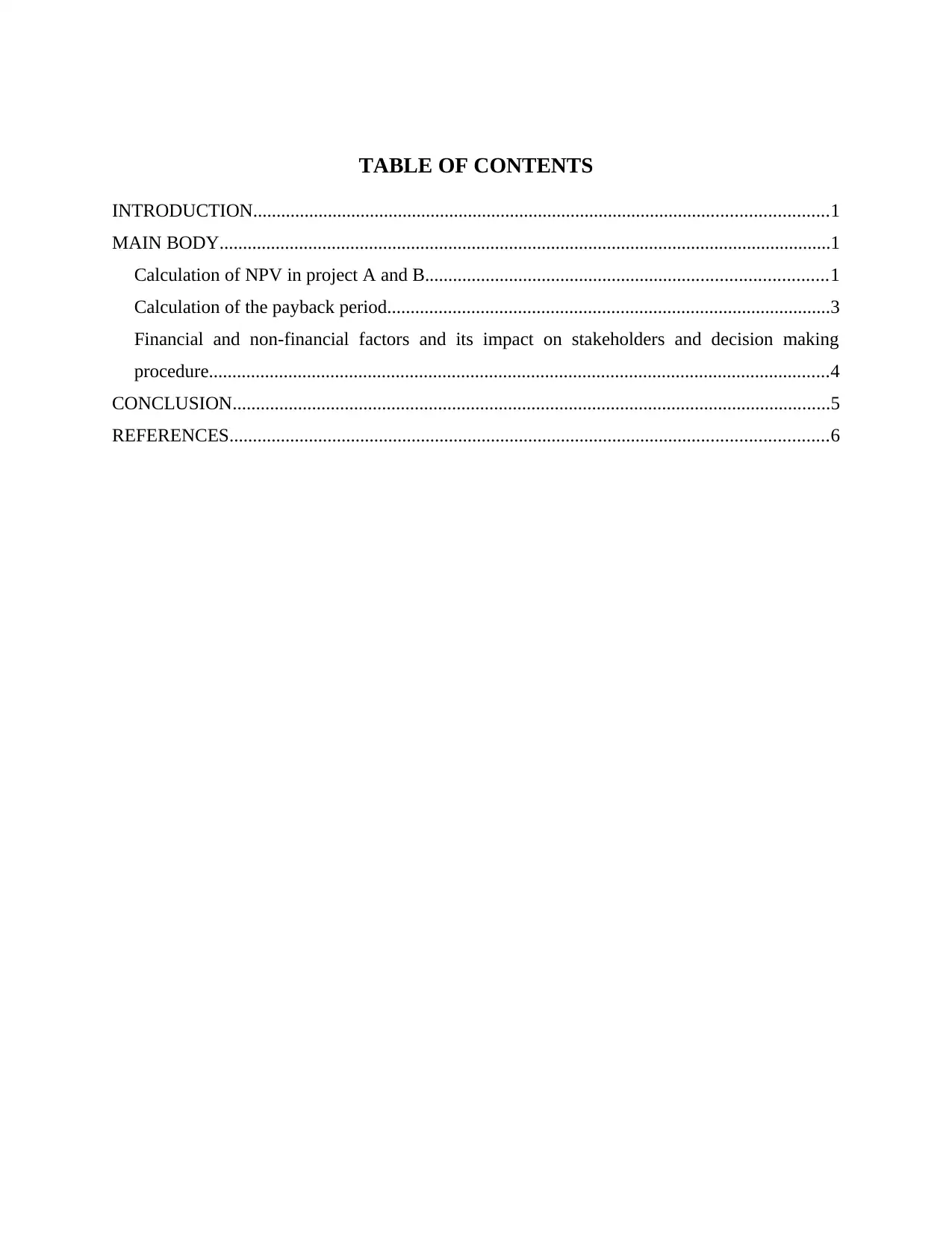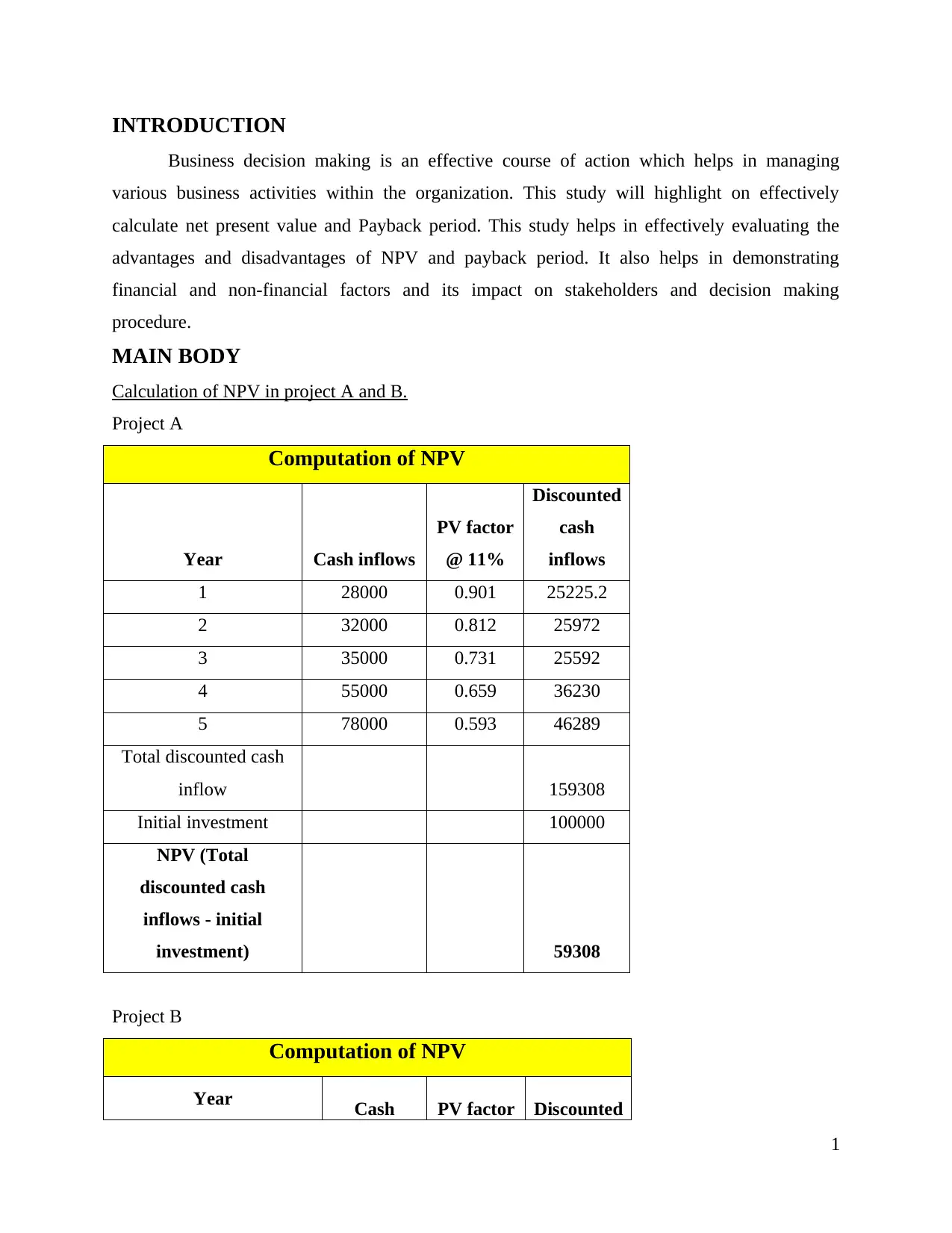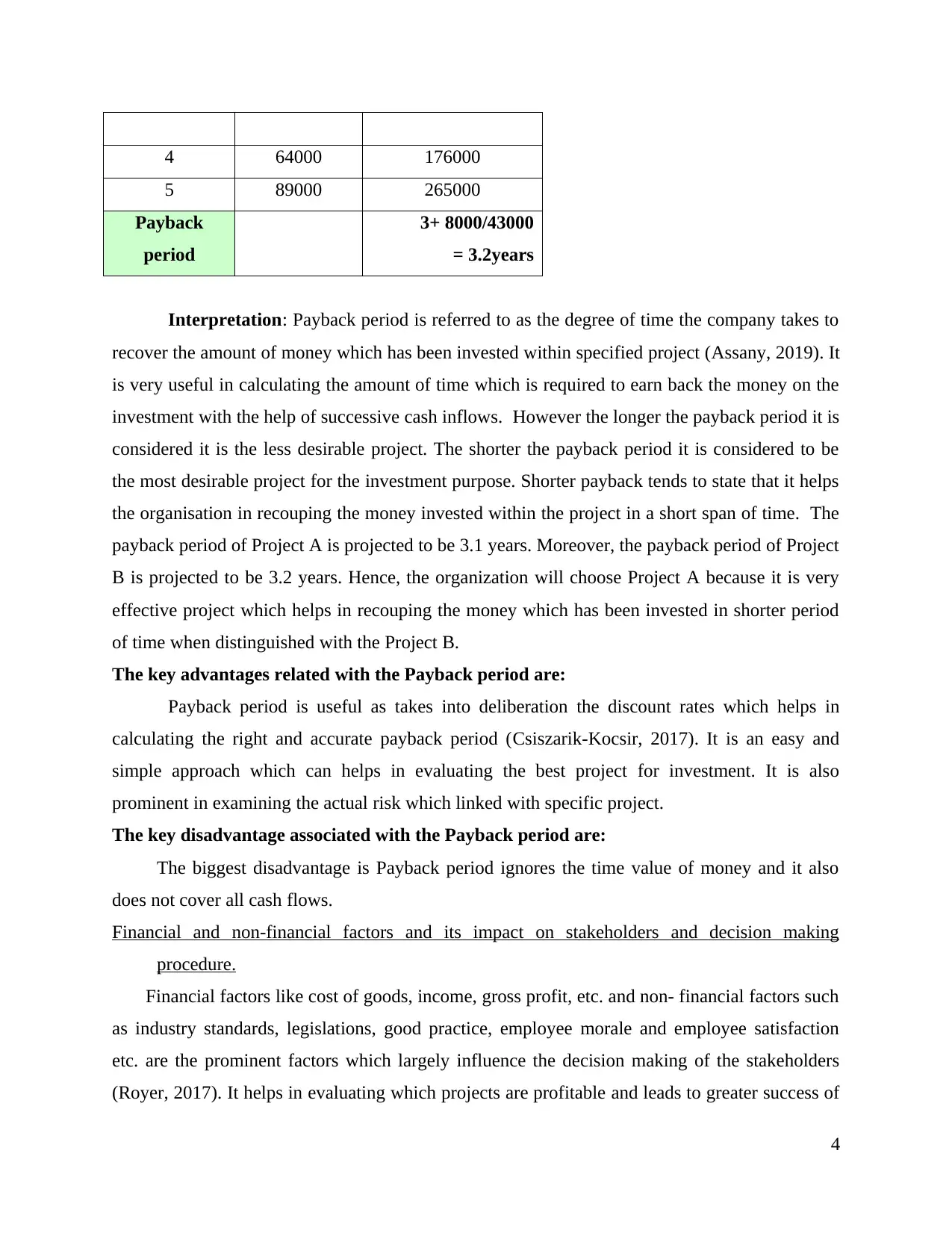Project Evaluation: NPV, Payback Period, and Decision Making Factors
VerifiedAdded on 2023/01/11
|8
|1374
|43
Report
AI Summary
This report provides a comprehensive analysis of business decision-making through the lens of financial tools like Net Present Value (NPV) and Payback Period. It begins with detailed calculations of NPV for two hypothetical projects (A and B), demonstrating how to determine the discounted cash inflows and initial investment to arrive at a positive NPV, indicating profitability. Following this, the report calculates the payback period for each project, illustrating the time required to recover the initial investment. The interpretation section highlights the advantages and disadvantages of both methods, emphasizing that Project B is chosen due to its higher NPV and Project A is chosen because of shorter payback period. Furthermore, the report explores the impact of financial and non-financial factors on stakeholders and the decision-making process, including elements like cost of goods, industry standards, and employee morale. The conclusion summarizes the findings, reinforcing the importance of NPV, payback period, and stakeholder considerations in effective business decision-making. The report concludes with a list of references including books, journals, and online resources.

Business decision making
Paraphrase This Document
Need a fresh take? Get an instant paraphrase of this document with our AI Paraphraser

TABLE OF CONTENTS
INTRODUCTION...........................................................................................................................1
MAIN BODY...................................................................................................................................1
Calculation of NPV in project A and B......................................................................................1
Calculation of the payback period...............................................................................................3
Financial and non-financial factors and its impact on stakeholders and decision making
procedure.....................................................................................................................................4
CONCLUSION................................................................................................................................5
REFERENCES................................................................................................................................6
INTRODUCTION...........................................................................................................................1
MAIN BODY...................................................................................................................................1
Calculation of NPV in project A and B......................................................................................1
Calculation of the payback period...............................................................................................3
Financial and non-financial factors and its impact on stakeholders and decision making
procedure.....................................................................................................................................4
CONCLUSION................................................................................................................................5
REFERENCES................................................................................................................................6

INTRODUCTION
Business decision making is an effective course of action which helps in managing
various business activities within the organization. This study will highlight on effectively
calculate net present value and Payback period. This study helps in effectively evaluating the
advantages and disadvantages of NPV and payback period. It also helps in demonstrating
financial and non-financial factors and its impact on stakeholders and decision making
procedure.
MAIN BODY
Calculation of NPV in project A and B.
Project A
Computation of NPV
Year Cash inflows
PV factor
@ 11%
Discounted
cash
inflows
1 28000 0.901 25225.2
2 32000 0.812 25972
3 35000 0.731 25592
4 55000 0.659 36230
5 78000 0.593 46289
Total discounted cash
inflow 159308
Initial investment 100000
NPV (Total
discounted cash
inflows - initial
investment) 59308
Project B
Computation of NPV
Year Cash PV factor Discounted
1
Business decision making is an effective course of action which helps in managing
various business activities within the organization. This study will highlight on effectively
calculate net present value and Payback period. This study helps in effectively evaluating the
advantages and disadvantages of NPV and payback period. It also helps in demonstrating
financial and non-financial factors and its impact on stakeholders and decision making
procedure.
MAIN BODY
Calculation of NPV in project A and B.
Project A
Computation of NPV
Year Cash inflows
PV factor
@ 11%
Discounted
cash
inflows
1 28000 0.901 25225.2
2 32000 0.812 25972
3 35000 0.731 25592
4 55000 0.659 36230
5 78000 0.593 46289
Total discounted cash
inflow 159308
Initial investment 100000
NPV (Total
discounted cash
inflows - initial
investment) 59308
Project B
Computation of NPV
Year Cash PV factor Discounted
1
⊘ This is a preview!⊘
Do you want full access?
Subscribe today to unlock all pages.

Trusted by 1+ million students worldwide

inflows @ 11%
cash
inflows
1 31000 0.901 27927.9
2 38000 0.812 30842
3 43000 0.731 31441
4 64000 0.659 42159
5 89000 0.593 52817
Total discounted cash
inflow 185187
Initial investment 120000
NPV (Total discounted
cash inflows - initial
investment) 65187
Interpretation: Net present value is difference between current value of the cash inflows
and outflows over a specified period of time. Positive net present value tends to state that the
projected earnings generated by the specific project tends to exceed the anticipated cost. The
positive net present value states that the project is profitable. The negative net present value
states that the project will result in occurrence of loss for the company (Ehrhardt, and Brigham,
2016). Moreover, the net present value is considered to be zero when there is no profit and no
loss situation. The positive net present value states that the investment is worthwhile and will
result in higher degree of profitability for the business. The NPV of the Project A is estimated to
be 59308 and the NPV of the Project B is estimated to be 65187. Hence, the management of the
organization will choose project B i.e., Laundrette project. This is because the net present value
is greater when compared with Project A. It will eventually result in more profitability to the
company.
The key advantages associated with the net present value are:
Net present value admit conventional pattern of cash flows which helps in attaining better
set of outcomes (Net Present Value (NPV), 2020). However, it also helps in considering all the
cash flows associated with specific duration of time. Moreover, net present value is an
2
cash
inflows
1 31000 0.901 27927.9
2 38000 0.812 30842
3 43000 0.731 31441
4 64000 0.659 42159
5 89000 0.593 52817
Total discounted cash
inflow 185187
Initial investment 120000
NPV (Total discounted
cash inflows - initial
investment) 65187
Interpretation: Net present value is difference between current value of the cash inflows
and outflows over a specified period of time. Positive net present value tends to state that the
projected earnings generated by the specific project tends to exceed the anticipated cost. The
positive net present value states that the project is profitable. The negative net present value
states that the project will result in occurrence of loss for the company (Ehrhardt, and Brigham,
2016). Moreover, the net present value is considered to be zero when there is no profit and no
loss situation. The positive net present value states that the investment is worthwhile and will
result in higher degree of profitability for the business. The NPV of the Project A is estimated to
be 59308 and the NPV of the Project B is estimated to be 65187. Hence, the management of the
organization will choose project B i.e., Laundrette project. This is because the net present value
is greater when compared with Project A. It will eventually result in more profitability to the
company.
The key advantages associated with the net present value are:
Net present value admit conventional pattern of cash flows which helps in attaining better
set of outcomes (Net Present Value (NPV), 2020). However, it also helps in considering all the
cash flows associated with specific duration of time. Moreover, net present value is an
2
Paraphrase This Document
Need a fresh take? Get an instant paraphrase of this document with our AI Paraphraser

appropriate measure which helps in determining the profitability of the project (Li, and Cai,
2017). Another key advantage associated with net present value is that it takes into consideration
the time value of money.
The key disadvantage associated with the net present value are:
Net present value tends to ignore the sunk cost. It also requires high degree of assumptions
to determine the cost of capital of the firm (Samet, and Jarboui, 2017). Moreover, there might be
variation in the size of the project. Net present value also does not take into consideration hidden
cost.
Calculation of the payback period
Project A
Computation of Payback period
Year
Total cash
flow
Cumulative cash
flow
1 28000 28000
2 32000 60000
3 35000 95000
4 55000 150000
5 78000 228000
Payback
period
3 + 5000 /55000
3 + 0.1
= 3.1 years
Project B
Computation of Payback period
Year
Total cash
flow
Cumulative cash
flow
1 31000 31000
2 38000 69000
3 43000 112000
3
2017). Another key advantage associated with net present value is that it takes into consideration
the time value of money.
The key disadvantage associated with the net present value are:
Net present value tends to ignore the sunk cost. It also requires high degree of assumptions
to determine the cost of capital of the firm (Samet, and Jarboui, 2017). Moreover, there might be
variation in the size of the project. Net present value also does not take into consideration hidden
cost.
Calculation of the payback period
Project A
Computation of Payback period
Year
Total cash
flow
Cumulative cash
flow
1 28000 28000
2 32000 60000
3 35000 95000
4 55000 150000
5 78000 228000
Payback
period
3 + 5000 /55000
3 + 0.1
= 3.1 years
Project B
Computation of Payback period
Year
Total cash
flow
Cumulative cash
flow
1 31000 31000
2 38000 69000
3 43000 112000
3

4 64000 176000
5 89000 265000
Payback
period
3+ 8000/43000
= 3.2years
Interpretation: Payback period is referred to as the degree of time the company takes to
recover the amount of money which has been invested within specified project (Assany, 2019). It
is very useful in calculating the amount of time which is required to earn back the money on the
investment with the help of successive cash inflows. However the longer the payback period it is
considered it is the less desirable project. The shorter the payback period it is considered to be
the most desirable project for the investment purpose. Shorter payback tends to state that it helps
the organisation in recouping the money invested within the project in a short span of time. The
payback period of Project A is projected to be 3.1 years. Moreover, the payback period of Project
B is projected to be 3.2 years. Hence, the organization will choose Project A because it is very
effective project which helps in recouping the money which has been invested in shorter period
of time when distinguished with the Project B.
The key advantages related with the Payback period are:
Payback period is useful as takes into deliberation the discount rates which helps in
calculating the right and accurate payback period (Csiszarik-Kocsir, 2017). It is an easy and
simple approach which can helps in evaluating the best project for investment. It is also
prominent in examining the actual risk which linked with specific project.
The key disadvantage associated with the Payback period are:
The biggest disadvantage is Payback period ignores the time value of money and it also
does not cover all cash flows.
Financial and non-financial factors and its impact on stakeholders and decision making
procedure.
Financial factors like cost of goods, income, gross profit, etc. and non- financial factors such
as industry standards, legislations, good practice, employee morale and employee satisfaction
etc. are the prominent factors which largely influence the decision making of the stakeholders
(Royer, 2017). It helps in evaluating which projects are profitable and leads to greater success of
4
5 89000 265000
Payback
period
3+ 8000/43000
= 3.2years
Interpretation: Payback period is referred to as the degree of time the company takes to
recover the amount of money which has been invested within specified project (Assany, 2019). It
is very useful in calculating the amount of time which is required to earn back the money on the
investment with the help of successive cash inflows. However the longer the payback period it is
considered it is the less desirable project. The shorter the payback period it is considered to be
the most desirable project for the investment purpose. Shorter payback tends to state that it helps
the organisation in recouping the money invested within the project in a short span of time. The
payback period of Project A is projected to be 3.1 years. Moreover, the payback period of Project
B is projected to be 3.2 years. Hence, the organization will choose Project A because it is very
effective project which helps in recouping the money which has been invested in shorter period
of time when distinguished with the Project B.
The key advantages related with the Payback period are:
Payback period is useful as takes into deliberation the discount rates which helps in
calculating the right and accurate payback period (Csiszarik-Kocsir, 2017). It is an easy and
simple approach which can helps in evaluating the best project for investment. It is also
prominent in examining the actual risk which linked with specific project.
The key disadvantage associated with the Payback period are:
The biggest disadvantage is Payback period ignores the time value of money and it also
does not cover all cash flows.
Financial and non-financial factors and its impact on stakeholders and decision making
procedure.
Financial factors like cost of goods, income, gross profit, etc. and non- financial factors such
as industry standards, legislations, good practice, employee morale and employee satisfaction
etc. are the prominent factors which largely influence the decision making of the stakeholders
(Royer, 2017). It helps in evaluating which projects are profitable and leads to greater success of
4
⊘ This is a preview!⊘
Do you want full access?
Subscribe today to unlock all pages.

Trusted by 1+ million students worldwide

the company. Financial and non-financial factors tends to largely influence the decision of the
key stakeholders such as creditors, employees, owners, customers, government, suppliers, union,
community, etc. of the organization. It tends to affect their relationship with the organization.
CONCLUSION
This study concludes that, positive NPV is selected because it is more profitable. Shortest
payback period is chosen because it helps in recouping the money in shorter time span.
Moreover, Financial and non-financial factors influence the decision making procedure.
5
key stakeholders such as creditors, employees, owners, customers, government, suppliers, union,
community, etc. of the organization. It tends to affect their relationship with the organization.
CONCLUSION
This study concludes that, positive NPV is selected because it is more profitable. Shortest
payback period is chosen because it helps in recouping the money in shorter time span.
Moreover, Financial and non-financial factors influence the decision making procedure.
5
Paraphrase This Document
Need a fresh take? Get an instant paraphrase of this document with our AI Paraphraser

REFERENCES
Books and Journals
Assany, M., 2019. Analysis of Sharia Financing Potentials on Fisheries Sector. Journal of
Finance and Islamic Banking, 1(2), pp.150-163.
Csiszarik-Kocsir, A., 2017. How to finance renewable energy projects–facts and
trends. Proceedings of FIKUSZ 2017, pp.44-56.
Ehrhardt, M.C. and Brigham, E.F., 2016. Corporate finance: A focused approach. Cengage
learning.
Li, S. and Cai, H., 2017. Risk-Aware Multi-Objective Optimization of Capital Structure for
Private Financing in Infrastructure Projects. In Computing in Civil Engineering 2017 (pp. 18-25).
Rossi, M., 2015. The use of capital budgeting techniques: an outlook from Italy. International
Journal of Management Practice, 8(1), pp.43-56.
Royer, J., 2017. Financing agricultural cooperatives with retained earnings. Agricultural Finance
Review.
Samet, M. and Jarboui, A., 2017. How does corporate social responsibility contribute to
investment efficiency?. Journal of Multinational Financial Management, 40, pp.33-46.
Online
Net Present Value (NPV). 2020. [ONLINE]. Available
through<https://www.investopedia.com/terms/n/npv.asp>
6
Books and Journals
Assany, M., 2019. Analysis of Sharia Financing Potentials on Fisheries Sector. Journal of
Finance and Islamic Banking, 1(2), pp.150-163.
Csiszarik-Kocsir, A., 2017. How to finance renewable energy projects–facts and
trends. Proceedings of FIKUSZ 2017, pp.44-56.
Ehrhardt, M.C. and Brigham, E.F., 2016. Corporate finance: A focused approach. Cengage
learning.
Li, S. and Cai, H., 2017. Risk-Aware Multi-Objective Optimization of Capital Structure for
Private Financing in Infrastructure Projects. In Computing in Civil Engineering 2017 (pp. 18-25).
Rossi, M., 2015. The use of capital budgeting techniques: an outlook from Italy. International
Journal of Management Practice, 8(1), pp.43-56.
Royer, J., 2017. Financing agricultural cooperatives with retained earnings. Agricultural Finance
Review.
Samet, M. and Jarboui, A., 2017. How does corporate social responsibility contribute to
investment efficiency?. Journal of Multinational Financial Management, 40, pp.33-46.
Online
Net Present Value (NPV). 2020. [ONLINE]. Available
through<https://www.investopedia.com/terms/n/npv.asp>
6
1 out of 8
Related Documents
Your All-in-One AI-Powered Toolkit for Academic Success.
+13062052269
info@desklib.com
Available 24*7 on WhatsApp / Email
![[object Object]](/_next/static/media/star-bottom.7253800d.svg)
Unlock your academic potential
Copyright © 2020–2025 A2Z Services. All Rights Reserved. Developed and managed by ZUCOL.





